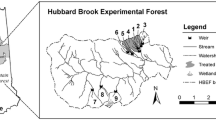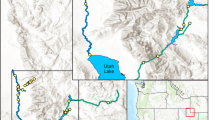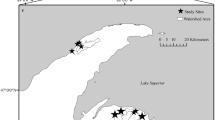Abstract
A growing body of research suggests that different land use activities may alter both the quantity and quality of dissolved organic carbon (DOC) exported from terrestrial landscapes. However, little is known about DOC from mixed-use landscapes where hydrology varies seasonally. This study examined how DOC and chemical properties of stream water were related to land use, drainage area, and streamflow in mixed-use landscape in the Willamette River Basin, Oregon. Stream water samples were collected at roughly monthly intervals over three water years from 21 sites whose drainage areas ranged from 1 to > 11,000 km2 and included pasture, forest, and developed land uses. DOC properties were characterized using PARAFAC (parallel factor) analyses of 3-D excitation and emission matrices (EEMs). We used the Cory-McKnight (CM) model, and we also developed a model unique to our samples. Thirteen components were identified using the CM model, and these were highly correlated with, and similar with respect to excitation and emission to the three components identified in our site-specific model. Fluorescent components of DOC were related to discharge and land cover, but not to drainage area. In our model, one component (C1) appeared to be associated with terrestrial detritus and was greater in streamflow from sites with forest/developed cover than from sites with high pasture cover. A second component (C2) was greater in streamflow from high-pasture sites than from high-forest sites. C2 was strongly correlated with a protein component identified in the CM model, and therefore we attributed this second component to more microbially-processed DOC. C1 increased significantly with discharge for both land covers, suggesting that periods of high flow produce less microbially-processed DOC from more surficial flow. C2 decreased significantly with discharge for both land covers, suggesting that deeper hydrologic flow paths produce more soil-associated, microbially processed DOC. SUVA254, often used as an index of chemical quality and aromaticity of DOC, was related only to streamflow but not land use, suggesting that while the chemistry of DOC differed among land use types as detected by EEMs analysis, the aromaticity of the DOC did not differ. The CM model and our site-specific model provided consistent results: those components that were highest in high pasture sites were also highest at low flow and appeared to be more microbially processed; components that were highest in low pasture sites were also greatest at high flow and appeared to reflect less microbially processed DOC. Taken together, these findings are consistent with a conceptual model of how differences in DOC chemistry among landscape types reflect differences in plant litter input chemistry, hydrologic connectivity, and degree of microbial processing. Such changes in DOC quality with land-use change can affect foodweb dynamics in receiving waters and change the balance between carbon storage and carbon flux to the atmosphere, and they imply that even non-intensive agricultural land use can have significant effects on terrestrial-aquatic carbon processes.













Similar content being viewed by others
References
Ågren A, Haei M, Köhler SJ, Bishop K, Laudon H (2010) Regulation of stream water dissolved organic carbon (DOC) concentrations during snowmelt; the role of discharge, winter climate and memory effects. Biogeosciences 7:2901–2913
Andersson CA, Bro R (2000) The N-way Toolbox for MATLAB. Chemom Intell Lab Syst 52:1–4
Asano Y, Compton JE, Church MR (2006) Hydrologic flowpaths influence inorganic and organic nutrient leaching in a forest soil. Biogeochemistry 81:191–204
Autio I, Soinne H, Helin J, Asmala E, Hoikkala L (2016) Effect of catchment land use and soil type on the concentration, quality, and bacterial degradation of riverine dissolved organic matter. Ambio 45:331–349
Burns MA, Barnard HR, Gabor RS, McKnight DM, Brooks PD (2016) Dissolved organic matter transport reflects hillslope to stream connectivity during snowmelt in a montane catchment. Water Resour Res 52:4905–4923
Cade-Menun BJ, Bell G, Baker-Ismail S, Fouli Y, Hodder K, McMartin DW, Perez-Valdivia C, Wu K (2013) Nutrient loss from Saskatchewan cropland and pasture in spring snowmelt runoff. Can J Soil Sci 93:445–458
Cawley KM, Wolski P, Mladenov N, Jaffe R (2012) Dissolved organic matter biogeochemistry along a transect of the Okavango Delta, Botswana. Wetlands 32:475–486
Cawley KM, Campbell J, Zwilling M, Jaffé R (2014) Evaluation of forest disturbance legacy effects on dissolved organic matter characteristics in streams at the Hubbard Brook Experimental Forest, New Hampshire. Aquat Sci 76(4):611–622
CCAL (2014) Analytical detection levels. http://ccal.oregonstate.edu/detection. Accessed 8 Oct 2014
Coble PG (1996) Characterization of marine and terrestrial DOM in seawater using excitation-emission matrix spectroscopy. Mar Chem 51(4):325–346
Coble PG (2007) Marine optical biogeochemistry: the chemistry of Ocean color. Chem Rev 107:402–418
Cole JJ, Prairie YT, Caraco NF, McDowell WH, Tranvik LJ, Striegl RG, Duarte CM, Kortelainen P, Downing JA, Middleburg JJ, Melack J (2007) Plumbing the global carbon cycle: integrating inland waters into the terrestrial carbon budget. Ecosystems 10:172–185. https://doi.org/10.1007/s10021-006-9013-8
Cory RM, McKnight DM (2005) Fluorescence spectroscopy reveals ubiquitous presence of oxidized and reduced quinones in dissolved organic matter. Environ Sci Technol 39:8142–8149
Cory RM, Miller MP, McKnight DM, Guerard JJ, Miller PL (2010) Effect of instrument-specific response on the analysis of fulvic acid fluorescence spectra. Limnol Oceanogr 8:67–78
Cory RM, Boyer EW, Mcknight DM (2011) In: Levia DF, Carlyle-Moses D, Tanaka T (eds) Forest hydrology and biogeochemistry, 1st edition. Springer, Dordrecht, pp 117–136
Dai KH, David MB, Vance GF (1996) Characterization of solid and dissolved carbon in a spruce-fir spodosol. Biogeochemistry 35:339–365
Ebert J (2013) Collecting 3-dimensional fluorescence scans. Page Fluorescence and LTER DOM Workshops. University of Colorado, Boulder, CO.
Erlandsson M, Cory N, Fölster J, Köhler S, Laudon H, Weyhenmeyer GA, Bishop K (2011) Increasing dissolved organic carbon redefines the extent of surface water acidification and helps resolve a classic controversy. Bioscience 61:614–618
Evans CD, Jones TG, Burden A, Ostle N, Zieliński P, Cooper MDA, Peacock M, Clark JM, Oulehle F, Cooper D, Freeman C (2012) Acidity controls on dissolved organic carbon mobility in organic soils. Glob Change Biol 18:3317–3331
Fellman JB, Miller MP, Corey R, D’Amore DV, White D (2009) Characterizing dissolved organic matter using PARAFAC modeling of fluorescence spectroscopy: a comparison of two models. Environ Sci Technol 43:6228–6234
Fuß T, Behounek B, Ulseth AJ, Singer GA (2017) Land use controls stream ecosystem metabolism by shifting dissolved organic matter and nutrient regimes. Freshw Biol 62:582–599
Graeber D, Boëchat IG, Encina-Montoya F, Esse C, Gelbrecht J, Goyenola G, Gücker B, Heinz M, Kronvang B, Meerhoff M, Nimptsch J, Pusch MT, Silva RCS, von Schiller D, Zwirnmann E (2015) Global effects of agriculture on fluvial dissolved organic matter. Sci Rep 5:16328
Hood E, Williams MW, McKnight DM (2005) Sources of dissolved organic matter (DOM) in a Rocky Mountain stream using chemical fractionation and stable isotopes. Biogeochemistry 74:231–255
Hosen JD, McDonough OT, Febria CM, Palmer MA (2014) Dissolved organic matter quality and bioavailability changes across an urbanization gradient in headwater streams. Environ Sci Technol 48:7817–7824
Hruška J, Krám P, McDowell WH, Oulehle F (2009) Increased dissolved organic carbon (DOC) in Central European streams is driven by reductions in ionic strength rather than climate change or decreasing acidity. Environ Sci Technol 43:4320–4326
Huang W, Chen RF (2009) Sources and transformations of chromophoric dissolved organic matter in the Neponset River Watershed. J Geophys Res 114:G00F05
Inamdar S, Singh S, Dutta S, Levia D, Mitchell M, Scott D, Bais H, McHale P (2011) Fluorescence characteristics and sources of dissolved organic matter for stream water during storm events in a forested mid-Atlantic watershed. J Geophys Res 116:G03043
Jin S, Yang L, Danielson P, Homer C, Fry J, Xian G (2013) A comprehensive change detection method for updating the National Land Cover Database to circa 2011. Remote Sens Environ 132:159–175
Johnson M, Couto E, Abdo M, Lehmann J (2011) Fluorescence index as an indicator of dissolved organic carbon quality in hydrologic flowpaths of forested tropical watersheds. Biogeochemistry 105:149–157
Kalbitz K, Schwesig D, Schmerwitz J, Kaiser K, Haumaier L, Glaser B, Ellerbrock R, Leinweber P (2003) Changes in properties of soil-derived dissolved organic matter induced by biodegradation. Soil Biol Biochem 35:1129–1142
Kramer MG, Lajtha K, Aufdenkampe AK (2017) Depth trends of soil organic matter C: N and 15 N natural abundance controlled by association with minerals. Biogeochemistry 136:237–248
Larsen LG, Aiken GR, Harvey JW, Noe GB, Crimaldi JP (2010) Using fluorescence spectroscopy to trace seasonal DOM dynamics, disturbance effects, and hydrologic transport in the Florida Everglades. J Geophys Res 115:G03001
Laudon H, Köhler S, Buffam I (2004) Seasonal TOC export from seven boreal catchments in northern Sweden. Aquat Sci 66:223–230
Lawaetz AJ, Stedmon CA (2009) Fluorescence intensity calibration using the Raman scatter peak of water. Appl Spectrosc 63:936–940
Lee BS (2015) Hydrologic and land cover effects on sources and fate of in-stream flourescent dissolved organic matter. PhD Dissertation, Oregon State University
Lee BS, Lajtha K (2016) Hydrologic and forest management controls on dissolved organic matter characteristics in headwater streams of old-growth forests in the Oregon Cascades. For Ecol Manag 380:11–22
Lu YH, Bauer JE, Canuel EA, Chambers RM, Yamashita Y, Jaffé R, Barrett A (2014) Effects of land use on sources and ages of inorganic and organic carbon in temperate headwater streams. Biogeochemistry 119:275–292
Mann PJ, Davydova A, Zimov N, Spencer RGM, Davydov S, Bulygina E, Zimov S, Holmes RM (2012) Controls on the composition and lability of dissolved organic matter in Siberia’s Kolyma River basin. J Geophys Res 117:1–15
Mann PJ, Spencer RGM, Dinga BJ, Poulsen JR, Hernes PJ, Fiske G, Salter ME, Wang ZA, Hoering KA, Six J, Holmes RM (2014) The biogeochemistry of carbon across a gradient of streams and rivers within the Congo Basin. J Geophys Res 119:2013JG002442
McKay L, Bondelid T, Dewald T, Johnston J, Moore R, Rea A (2012) NHDPlus version 2: user guide. United States Environmental Protection Agency, Washington, D.C.
McKnight DM, Boyer EW, Westerhoff PK, Doran PT, Kulbe T, Andersen DT (2001) Spectrofluorometric characterization of dissolved organic matter for indication of precursor organic material and aromaticity. Limonol Oceanogr 46:38–48
Miller MP, McKnight DM, Cory RM, Williams MW, Runkel RL (2006) Hyporheic exchange and fulvic acid redox reactions in an alpine stream/wetland ecosystem, colorado front range. Environ Sci Technol 40:5943–5949
Miller MP, Simone BE, McKnight DM, Cory RM, Williams MW, Boyer EW (2010) New light on a dark subject: comment. Aquat Sci 72:269–275
Monteith DT, Stoddard JL, Evans CD, Wit HAD, Forsius M, Høgåsen T, Wilander A, Skjelkvåle BL, Jeffries DS, Vuorenmaa J, Keller B, Kopácek J, Vesely J (2007) Dissolved organic carbon trends resulting from changes in atmospheric deposition chemistry. Nature 450:537–540
Morrison Erway M, Motter K, Karen B (2004) National Wadeable Stream Assessment: Water Chemistry Laboratory Manual (EPA841-B-04-008). U.S. Environmental Protection Agency, Office of Water and Office of Research and Development, Washington, D.C.
O’Donnell JA, Aiken GR, Kane ES, Jones JB (2010) Source water controls on the character and origin of dissolved organic matter in streams of the Yukon River basin, Alaska. J Geophys Res 115:G03025
Oni SK, Futter MN, Teutschbein C, Laudon H (2014) Cross-scale ensemble projections of dissolved organic carbon dynamics in boreal forest streams. Clim Dyn 42:2305–2321
Petrone KC (2010) Catchment export of carbon, nitrogen, and phosphorus across an agro-urban land use gradient, Swan-Canning River system, southwestern Australia. J Geophys Res 115:G01016
Schelker J, Eklöf K, Bishop K, Laudon H (2012) Effects of forestry operations on dissolved organic carbon concentrations and export in boreal first-order streams. J Geophys Res 117:G1
Singh S, Inamdar S, Scott D (2013) Comparison of two PARAFAC models of dissolved organic matter fluorescence for a mid-atlantic forested watershed in the USA. J Ecosyst. https://doi.org/10.1155/2013/532424
Singh S, Inamdar S, Mitchell M, McHale P (2014) Seasonal pattern of dissolved organic matter (DOM) in watershed sources: influence of hydrologic flow paths and autumn leaf fall. Biogeochemistry 118:321–337
Sollins P, Kramer MG, Swanston C, Lajtha K, Filley T, Aufdenkampe AK, Wagai R, Bowden RD (2009) Sequential density fractionation across soils of contrasting mineralogy: evidence for both microbial- and mineral-controlled soil organic matter stabilization. Biogeochemistry 96:209–231
Spencer RGM, Aiken GR, Wickland KP, Striegl RG, Hernes PJ (2008) Seasonal and spatial variability in dissolved organic matter quantity and composition from the Yukon River basin, Alaska. Global Biogeochem Cycles 22:1–13
Stedmon CA, Bro R (2008) Characterizing dissolved organic matter fluorescence with parallel factor analysis: a tutorial. Environ Res 6:572–579
Stedmon CA, Markager S (2005) Resolving the variability in dissolved organic matter fluorescence in a temperate estuary and its catchment using PARAFAC analysis. Limonol Oceanogr 50:686–697
Stedmon CA, Markager S, Bro R (2003) Tracing dissolved organic matter in aquatic environments using a new approach to fluorescence spectroscopy. Mar Chem 82:239–254. https://doi.org/10.1016/S0304-4203(03)00072-0
Toosi ER, Schmidt JP, Castellano MJ (2014) Land use and hydrologic flowpaths interact to affect dissolved organic matter and nitrate dynamics. Biogeochemistry 120:89–104
Volk C, Kaplan LA, Robinson J, Johnson B, Wood L, Zhu HW, LeChevallier M (2005) Fluctuations of dissolved organic matter in river used for drinking water and impacts on conventional treatment plant performance. Environ Sci Technol 39:4258–4264
Weishaar JL, Aiken GR, Bergamaschi BA, Fram MS, Fujii R, Mopper K (2003) Evaluation of specific ultraviolet absorbance as an indicator of the chemical composition and reactivity of dissolved organic carbon. Environ Sci Technol 37:4702–4708
Williams CJ, Yamashita Y, Wilson HF, Jaffe R, Xenopoulos MA (2010) Unraveling the role of land use and microbial activity in shaping dissolved organic matter characteristics in stream ecosystems. Limnol Oceanogr 55:1159–1171
Williams CJ, Frost PC, Morales-Williams AM, Larson JH, Richardson WB, Chiandet AS, Xenopoulos MA (2016) Human activities cause distinct dissolved organic matter composition across freshwater ecosystems. Glob Change Biol 22:613–626
Wilson HF, Xenopoulos M (2008) Ecosystem and seasonal control of stream dissolved organic carbon along a gradient of land use. Ecosystems 11:555–568. https://doi.org/10.1007/s10021-008-9142-3
Wilson HF, Xenopoulos M (2009) Effects of agricultural land use on the composition of fluvial dissolved organic matter. Nat Geosci 2:37–41
Winterdahl M, Erlandsson M, Futter MN, Weyhenmeyer GA, Bishop K (2014) Intra-annual variability of organic carbon concentrations in running waters: Drivers along a climatic gradient. Global Biogeochem Cycles 28:451–464
Yamashita Y, Kloeppel BD, Knoepp J, Zausen GL, Jaffé R (2011) Effects of watershed history on dissolved organic matter characteristics in headwater streams. Ecosystems 14:1110–1122
Yano Y, Lajtha K, Sollins P, Caldwell B (2004) Chemical and seasonal controls on the dynamics of dissolved organic matter in a coniferous old-growth stand in the Pacific Northwest. USA. Biogeochemistry 71(2):197–223
Acknowledgements
The study was partially funded by the Institute for Water and Watersheds, Dr. Michael Campana at Oregon State University, by NSF 1440409 to J. Jones, by NSF DEB 1257032 to K. Lajtha, and by NSF OCE 0962362 to A. E. White. We thank Katie Watkins-Brandt and Kathryn Motter for lab support.
Author information
Authors and Affiliations
Corresponding author
Additional information
Responsible Editor: Sujay Kaushal.
Rights and permissions
About this article
Cite this article
Lee, B.S., Lajtha, K., Jones, J.A. et al. Fluorescent DOC characteristics are related to streamflow and pasture cover in streams of a mixed landscape. Biogeochemistry 140, 317–340 (2018). https://doi.org/10.1007/s10533-018-0494-2
Received:
Accepted:
Published:
Issue Date:
DOI: https://doi.org/10.1007/s10533-018-0494-2




